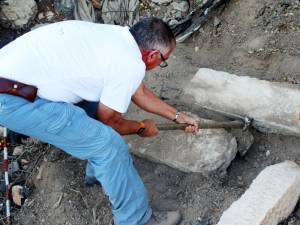The recent uncovering of gravestone inscriptions in northern Israel provides new evidence of thousands of years of Jewish history in the Land of Israel.
A most recent archaeological discovery further proving thousands of years of Jewish history in the Land of Israel, took place with the uncovering of three ancient gravestones in the north with inscriptions written in Aramaic and Greek, two of which refer to the buried individuals as rabbis.
The discovery of the 1,700-year-old epitaphs was made due to information received from residents of Moshav Zippori in the north, which led to a joint investigation by researchers from the Kinneret Institute for Galilean Archaeology of the Kinneret Academic College and the Israel Antiquities Authority (IAA).
Aramaic was the everyday language used by the Jews in the period of the Mishnah and Talmud (central texts of rabbinic Judaism), but some of them also spoke and read Greek, and thus there are also funerary inscriptions in that language. The two Aramaic inscriptions mention individuals referred to as “rabbis” who were buried in the western cemetery of Zippori; their names have not yet been deciphered.
According to Dr. Motti Aviam of the Kinneret Institute, “the importance of the epitaphs lies in the fact that these reflect the everyday life of the Jews of Zippori and their cultural world. Researchers are uncertain as to the meaning of the term ‘rabbi’ at the time when Rabbi Yehuda HaNasi [135-219 CE, editor of the Mishnah in its final form) resided in Zippori together with the Tannaim and after him, by the Amoraim – the large groups of sages that studied in the city’s houses of learning.”

Researcher Aharoni Amitai with the inscriptions uncovered in Zippori. (Miki Peleg, Israel Antiquities Authority)
A surprising element in the newly discovered inscriptions is that one of the deceased was called “The Tiberian,” Aviam continues. “This is already the second instance of someone from Tiberias being buried in the cemetery at Zippori. It is quite possible that Jews from various parts of Galilee were brought to Zippori to be buried in the wake of the important activity carried out there by Rabbi Yehuda HaNasi . Another possibility is that the man moved to Zippori and died there, but wanted to be remembered as someone who originally came from Tiberias.”
Aviam also explains that “in the second Aramaic epitaph, the word le-olam (forever) appears for the first time in inscriptions found at Zippori. The term le-olam is known from funerary inscriptions in Bet She‘arim [in the lower western Galilee] and elsewhere and means that the deceased’s burial place will remain his forever and that no one will take it from him. Both inscriptions end with the Hebrew blessing shalom.”
The Greek inscription mentions the name Jose, which was very common among Jews living in Israel and abroad.
So far, 17 funerary inscriptions have been documented in the Zippori study, most of them written in Aramaic. Contrasting this are the funerary inscriptions found in Tiberias – the second capital of the Galilee – which were mainly written in Greek. Several of the ancient inhabitants from Zippori are mentioned in these inscriptions, which include the names of rabbis and often mention their professions.
Zippori was the first capital of the Galilee from the time of the Hasmonean dynasty until the establishment of Tiberias in the first century CE. Jewish life in the city was rich and diverse, as indicated by the numerous ritual baths discovered in the excavation. The influence of Roman culture was also evident, as reflected in the design of the town with its paved streets, theater and bathhouses. The wealth of inscriptions from the cemeteries attests to the strong Jewish presence and the city’s social elite in the late Roman period.
The newly-found inscriptions will be studied by a team of researchers, which will likely lead to more discoveries. Upon completion of their research, the IAA and the Kinneret Academic College will present the inscriptions to the general public.
By: United with Israel Staff
(With files from the GPO and MFA)
